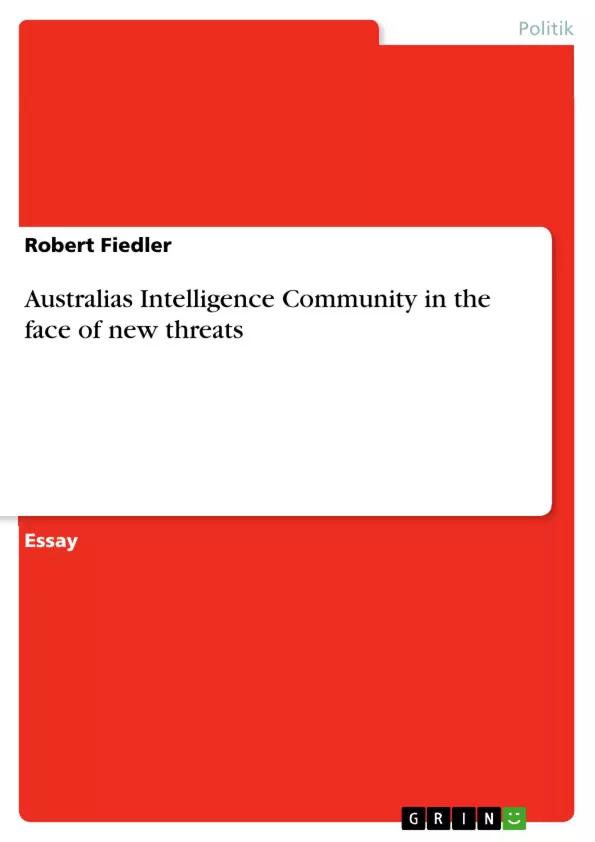During the cold war Australian intelligence agencies did what intelligence agencies where expected to do, gathering information and knowledge on a defined enemy represented by states or military alliances such as the Warsaw Pact. In a post-cold war era, these conventional threats still exist, however they are overlaid by other security threats such as regional instability, the rise of international terrorism, the proliferation of weapons of mass destruction, transnational crime and non-human agency threats such as climate change. The problem with this new security agenda is the asymmetry of these new threats since the nation state Australia has to cope with groups, networks, non-state actors, or even individuals, some of them are hard to detect and even harder to combat. Therefore, strategic uncertainty has become one of the defining determinants in a new security environment. The rapid growth of human and financial resources devoted to Australian Intelligence demonstrate the relevance conceded to intelligence, now considered to be the “the most effective tool in the struggle against new security threats” (Ungerer, 2008a, p. 1). Yet, it is necessary to analyze if Australia’s intelligence community (AIC) measure up to the high expectations and challenges posed by the new security agenda. This paper will provide an assessment of AIC’s efforts to combat asymmetric threats by analyzing the performance of intelligence agencies in the face of selected asymmetric threats. Based on the results of this assessment, steps towards a more effective intelligence answer to non-conventional security threats will be proposed.
Inhaltsverzeichnis
- Australia's Intelligence Community in the face of new threats
- The advent of new security threats since the Berlin Wall came down
- The performance of Australia's intelligence community to combat asymmetric threats
- Threats for Australia's security are manifold
- Asymmetric threats are not only imposed by human agency such as terrorism or transnational crimes
- As outlined above, Australia's intelligence agencies still have problems to adapt to a new asymmetric threat environment
Zielsetzung und Themenschwerpunkte
Dieser Artikel analysiert die Fähigkeit der australischen Geheimdienste, asymmetrischen Bedrohungen zu begegnen. Der Fokus liegt auf der Reaktion der Geheimdienste auf ausgewählte asymmetrische Bedrohungen wie Terrorismus, grenzüberschreitende Kriminalität und den Klimawandel.
- Die Anpassung der australischen Geheimdienste an die veränderte Sicherheitslage nach dem Kalten Krieg
- Die Leistungsfähigkeit der australischen Geheimdienste im Kampf gegen asymmetrische Bedrohungen
- Die Herausforderungen, denen die Geheimdienste bei der Bekämpfung des Terrorismus, der grenzüberschreitenden Kriminalität und des Klimawandels begegnen
- Die strukturellen Herausforderungen innerhalb der australischen Geheimdienste
- Die Notwendigkeit einer effizienteren und koordinierten Reaktion auf asymmetrische Bedrohungen
Zusammenfassung der Kapitel
- Der Artikel beginnt mit einer Analyse der neuen Sicherheitsbedrohungen, die nach dem Ende des Kalten Krieges aufgetreten sind. Der Fokus liegt dabei auf der Asymmetrie dieser Bedrohungen, die es den Geheimdiensten erschwert, ihnen effektiv zu begegnen.
- Im zweiten Kapitel wird die Reaktion der australischen Geheimdienste auf den Terrorismus untersucht. Dabei wird deutlich, dass die Terrorismusbekämpfung einen hohen Stellenwert einnimmt und erhebliche Ressourcen beansprucht.
- Im dritten Kapitel werden die Herausforderungen bei der Bekämpfung der grenzüberschreitenden Kriminalität analysiert. Die Geheimdienste stehen hier vor dem Problem, dass ihre Erkenntnisse nur begrenzt zur Strafverfolgung eingesetzt werden können.
- Im vierten Kapitel wird der Klimawandel als neue Sicherheitsbedrohung behandelt. Die Geheimdienste müssen sich mit wissenschaftlichen Institutionen zusammenarbeiten, um diese Herausforderung zu bewältigen.
- Im letzten Kapitel werden die Schwierigkeiten der australischen Geheimdienste bei der Anpassung an ein asymmetrisches Bedrohungsumfeld zusammengefasst. Der Artikel stellt fest, dass die Geheimdienste vor erheblichen strukturellen Herausforderungen stehen und dringend einer Reform bedürfen.
Schlüsselwörter
Die wichtigsten Schlüsselwörter dieses Artikels sind: Asymmetrische Bedrohungen, Terrorismus, grenzüberschreitende Kriminalität, Klimawandel, australische Geheimdienste, Leistungsfähigkeit, strukturelle Herausforderungen, Reform.
- Arbeit zitieren
- MSc. M.A. Robert Fiedler (Autor:in), 2008, Australias Intelligence Community in the face of new threats, München, GRIN Verlag, https://www.hausarbeiten.de/document/163698


